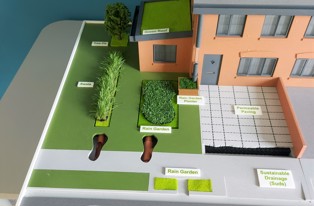The Council's role
Lead Local Flood Authority
We lead on the management of flood risk in Nottinghamshire. In this role, we work alongside partners to manage flooding from local sources: surface water, ordinary watercourses and groundwater.
In 2023, as part of our duties as Lead Local Flood Authority (LLFA), we carried out an update of our Preliminary Flood Risk Assessment (PFRA).
A PFRA is an assessment of:
- floods that have taken place in the past
- floods that could take place in the future
It considers flooding from surface water runoff, groundwater and ordinary watercourses.
View the Preliminary Flood Risk Assessment 2023-2029 report [PDF]
The following documents contain the information that this update generated.
- Map A - Number of Years Flooding Recorded [PDF]
- Map B - Number of Years Internal Flooding Recorded [PDF]
- Map C - Number of Recorded Flooding Incidents per km2 [PDF]
- Map D - Number of Properties Historically Flooded [PDF]
- Map E- Number of People at Risk of Flooding [PDF]
- Map F- Number of Properties at Risk of Flooding [PDF]
- Map G - Number of Residential Properties at Risk [PDF]
- Map H - Number of Commercial Properties at Risk of Flooding [PDF]
- Map I - Number of Critical Services at Risk of Flooding [PDF]
- Map J - Historical Flood Records and Properties at Risk Overlap [PDF]
- Map K - Susceptibility to groundwater flooding [PDF]
- Map L - Cultural Heritage Sites at Risk of Flooding [PDF]
- Map M - Cluster Analysis [PDF]
- Map N - Environmental Waste Sites at Risk of Flooding [PDF]
In its role as Lead Local Flood Authority (LLFA) the County Council has permissive powers and statutory duties to manage and co-ordinate local flood risk management activities in Nottinghamshire. Local flood risk means flooding from surface water (overland runoff), groundwater and smaller watercourses (known as Ordinary Watercourses).
The County Council is required under the Flood and Water Management Act 2010 to publish a Local Flood Risk Management Strategy including an Action Plan that identifies key objectives to shape the delivery of the flood risk management services in Nottinghamshire in partnership with the other Risk Management Authorities.
The Strategy was formally adopted by the Authority in September 2016.
- Nottinghamshire Local Flood Risk Management Strategy 2021-27 [PDF]
- Strategic Environmental Assessment [PDF]
- Figure A1: Risk of Flooding from Surface Water [PDF]
- Figure A2: Risk of Surface Water Flooding to Critical Infrastructure [PDF]
- Figure A3: Risk of Surface Water Flooding to Heritage and Nature Conservation [PDF]
- Figure A4: Risk to Agricultural Land from Surface Water Flooding [PDF]
- Figure A5: Risk of Flooding from Groundwater [PDF]
- Figure A6: Disused Mine Locations and Risk of Flooding from Groundwater [PDF]
- Figure A7a: Historic Flood Records (up to 2011) [PDF]
- Figure A7b: Recent Flood Records 2012-15 [PDF]
- Figure A8: Main Rivers and Ordinary Watercourses in Nottinghamshire [PDF]
- Figure A9: Risk of Flooding from Main Rivers [PDF]
- Appendix B: Nottinghamshire County Council Local Flood Risk Management Strategy Action Plan [PDF]
- Appendix C: Status of Legislation for Local Flood Risk Management [PDF]
- Appendix D: National, Regional, Local and Corporate Strategies [PDF]
- Appendix E: Summary of Local Engagement Survey Responses [PDF]
- Appendix F: Property at risk from surface water flooding [PDF]
One of our duties as the Lead Local Flood Authority is to report on flooding incidents under Section 19 of the Flood and Water Management Act (2010).
A Section 19 Report outlines what happened during a flooding incident and whether the relevant Risk Management Authorities have exercised or will exercise their responsibilities but it does not identify specific measures to prevent future flooding.
1. On becoming aware of a flood in its area, a lead local flood authority must, to the extent that it considers it necessary or appropriate, investigate:
(a) Which Risk Management Authorities (RMAs) have relevant flood risk management functions.
(b) Whether each of those risk management authorities has exercised, or is proposing to exercise, those functions in response to the flood.
2. Where an authority carries out an investigation under subsection (1) it must:-
(a) Publish the results of its investigation.
(b) Notify any relevant risk management authorities
Section 19 reports:
January 2025
- Costock S19 report January 2025 [PDF]
- East Leake S19 report January 2025 [PDF]
- Zouch S19 report January 2025 [PDF]
- Newark on Trent S19 report January 2025 [PDF]
January 2024:
- Burton Joyce S19 Storm Henk Jan 2024 [PDF]
- Collingham S19 Storm Henk Jan 2024 [PDF]
- Colwick S19 Storm Henk Jan 2024 [PDF]
- Costock S19 Storm Henk Jan 2024 [PDF]
- Farndon S19 Storm Henk Jan 2024 [PDF]
- Girton S19 Storm Henk Jan 2024 [PDF]
- Gunthorpe S19 Storm Henk Jan 2024 [PDF]
- Lowdham S19 Storm Henk Jan 2024 [PDF]
- Newark On Trent S19 Storm Henk Jan 2024 [PDF]
- Tollerton S19 Storm Henk Jan 2024 [PDF]
- Radcliffe On Trent S19 Storm Henk Jan 2024 [PDF]
- Retford S19 Storm Henk Jan 2024 [PDF]
- Stapleford S19 Storm Henk Jan 2024 [PDF]
- Woodborough S19 Storm Henk Jan 2024 [PDF]
- Worksop S19 Storm Henk Jan 2024 [PDF]
- Zouch S19 Storm Henk Jan 2024 [PDF]
October 2023:
- Arnold section 19 report October 2023 [PDF]
- Bilsthorpe section 19 report October 2023 [PDF]
- Blidworth section 19 report October 2023 [PDF]
- Carlton on Trent section 19 report October 2023 [PDF]
- Caunton section 19 report October 2023 [PDF]
- Cossall section 19 report October 2023 [PDF]
- East Markham section 19 report October 2023 [PDF]
- Eastwood section 19 report October 2023 [PDF]
- Edingley section 19 report October 2023 [PDF]
- Edwinstowe section 19 report October 2023 [PDF]
- Egmanton section 19 report October 2023 [PDF]
- Epperstone section 19 report October 2023 [PDF]
- Hucknall section 19 report October 2023 [PDF]
- Jacksdale section 19 report October 2023 [PDF]
- Kirby in Ashfield section 19 report October 2023 [PDF]
- Kirklington section 19 report October 2023 [PDF]
- Laneham section 19 report October 2023 [PDF]
- Lowdham section 19 report October 2023 [PDF]
- Maplebeck section 19 report October 2023 [PDF]
- Maythorne section 19 report October 2023 [PDF]
- Newark on Trent section 19 report October 2023 [PDF]
- Ompton section 19 report October 2023 [PDF]
- Ordsall section 19 report October 2023 [PDF]
- Oxton section 19 report October 2023 [PDF]
- Pleasley section 19 report October 2023 [PDF]
- Radcliffe on Trent section 19 report October 2023 [PDF]
- Retford section 19 report October 2023 [PDF]
- Rockley with Markham Moor and West Drayton section19 report October 2023 [PDF]
- Selston section 19 report October 2023 [PDF]
- Shireoaks section 19 report October 2023 [PDF]
- Southwell section 19 report October 2023 [PDF]
- Stapleford section 19 report October 2023 [PDF]
- Sutton in Ashfield section 19 report October 2023 [PDF]
- Sutton on Trent section 19 report October 2023 [PDF]
- Thurgarton section 19 report October 2023 [PDF]
- Toton section 19 report October 2023 [PDF]
- Treswell section 19 report October 2023 [PDF]
- Trowell section 19 report October 2023 [PDF]
- Woodborough section 19 report October 2023 [PDF]
- Worksop section 19 report October 2023 [PDF]
September 2023
Other reports
- Arnold Section 19 Report June 2019 [PDF]
- Arnold Section 19 Report July 2014 [PDF]
- Beeston and Chilwell Section 19 Report June 2020 [PDF]
- Bingham Section 19 Report February 2020 [PDF]
- Bingham Section 19 Report November 2019 [PDF]
- Calverton Section 19 Report July 2013 [PDF]
- Carlton on Trent Section 19 Report November 2012 [PDF]
- Cotgrave Section 19 Report February 2020 [PDF]
- Cropwell Butler Section 19 Report July 2012 [PDF]
- Cropwell Butler Section 19 Report February 2020 [PDF]
- East Markham Section 19 Report February 2020 [PDF]
- Eastwood Section 19 Report July 2013 [PDF]
- Egmanton Section 19 Report November 2019 [PDF]
- Gotham Section 19 Report February 2020 [PDF]
- Gotham Section 19 Report June 2016 [PDF]
- Gotham Section 19 Report November 2019 [PDF]
- Hucknall Section 19 Report July 2013 [PDF]
- Jacksdale Section 19 Report November 2019 [PDF]
- Kimberley Section 19 Report September 2019 [PDF]
- Lowdham Section 19 Report February 2020 [PDF]
- Lowdham Section 19 Report July 2013 [PDF]
- Lowdham Section 19 Report November 2019 [PDF]
- Mansfield Section 19 Report June 2016 [PDF]
- Ollerton Section 19 Report June 2020 [PDF]
- Radcliffe On Trent Section 19 Report February 2020 [PDF]
- Ravenshead Section 19 Report April 2023 [PDF]
- Retford Section 19 Report November 2019 [PDF]
- Rhodesia Section 19 Report November 2019 [PDF]
- Ruddington Section 19 Report June 2020 [PDF]
- Shireoaks Section 19 Report November 2019 [PDF]
- Sutton Bonington Section 19 Report February 2020 [PDF]
- Sutton-on-Trent Section 19 Report June 2018 [PDF]
- Thurgarton Section 19 Report July 2013 [PDF]
- Tollerton Section 19 Report February 2020 [PDF]
- Tollerton Section 19 Report November 2019 [PDF]
- Trowell Section 19 Report February 2020 [PDF]
- Woodborough Section 19 Report February 2020 [PDF]
- Worksop Section 19 Report November 2019 [PDF]
- Worksop Section 19 Report August 2022 [PDF]
Under section 21 of the Flood and Water Management Act 2010, each Lead Local Flood Authority (LLFA) in England and Wales has to establish and maintain a register of structures or features which, in the opinion of the authority, are likely to have a significant effect on flood risk in its locality. This includes a record of information about each of those structures or features, including information about ownership and state of repair. LLFA's also have a duty to arrange for the register to be available for inspection by the public. The record does not need to be made available to the public.
To promote both community partnership working and to allow cohesion and ease of transitions between our working borders for the public, the County Council has published its Asset Register together with Nottingham City Council.
To assess if a location has a possibility of flooding, view the flood probability map.
Have you ever wondered how the landscape such as hills, valleys and roads affects the flow of water into streams, rivers and wetlands?
Our Flood Risk Management Team’s new Augmented Reality Sandbox is able to model all of this and is now being used in schools to educate young people about the impacts of flooding.
You can request a visit from the sandbox to your school, community event or parish council meeting by emailing: flood.team@nottscc.gov.uk
Have you ever wondered how conventional drainage compares to sustainable drainage features? Our SuDS Model showcases the benefits of using sustainable drainage over that of older conventional drainage.
You can request a visit from the sandbox to your school, community event or parish council meeting by emailing: flood.team@nottscc.gov.uk
Contact us
Get in touch for more information about our flood risk planning and responsibilities.
- email: flood.team@nottscc.gov.uk
- telephone: Customer Service Centre on 0300 500 80 80.











